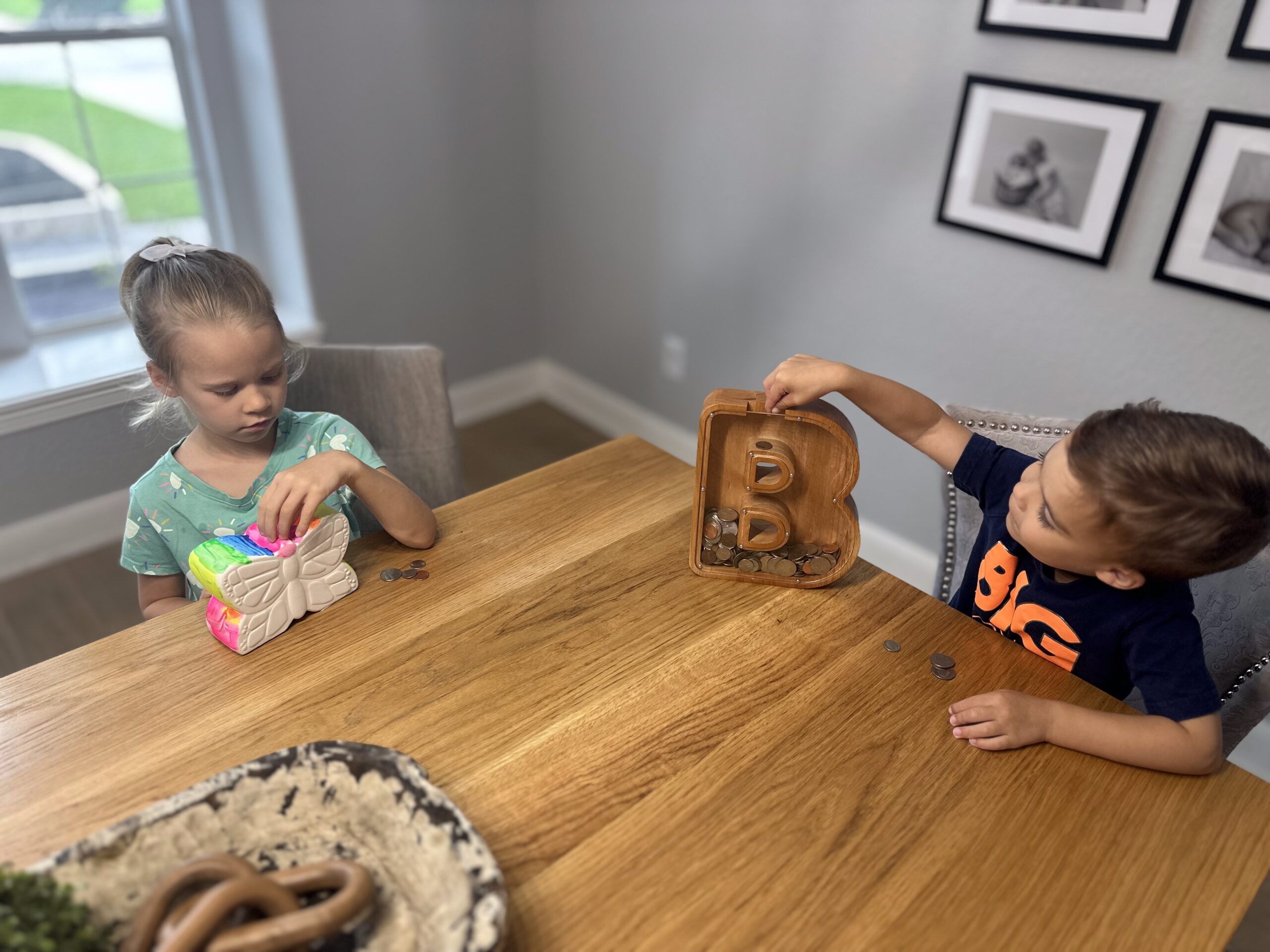April is Financial Literacy Month, making it the perfect time to teach kids about one of the most fundamental money skills: saving. For parents looking to instill smart money habits early, a simple piggy bank can be a powerful tool. Not only does it make saving tangible, but it also helps children develop financial discipline—an essential skill for future financial success. If you’re a parent planning for your child’s financial future, these fun and interactive strategies will help make saving money a lifelong habit.
The “Save, Spend, Give” Piggy Bank
Rather than using just one piggy bank, consider using three labeled containers: Save, Spend, and Give. This method teaches kids that money has multiple purposes.
- Save: This portion is for long-term goals.
- Spend: This is for fun purchases.
- Give: This portion is for donating to a charity or helping someone in need. By physically dividing their money, kids can learn the importance of budgeting and financial responsibility.
📚 Recommended Read: The Berenstain Bears’ Trouble with Money by Stan and Jan Berenstain – A great book to introduce kids to saving and spending wisely.
The 10% Savings Rule
A great starting point for kids is teaching them to always save at least 10% of any money they receive. If they get $10 for their birthday, they should put at least $1 into their piggy bank before deciding what to do with the rest. This introduces the concept of saving for the future and demonstrates how small contributions add up over time.
💡 Try This: Use the FamZoo app (FamZoo.com) to create a virtual family bank where kids can track their savings and spending digitally.
The Matching Challenge
To encourage saving, introduce a matching system—for every dollar your child saves, you contribute a matching amount. This creates an exciting incentive and mimics the concept of employer-matched retirement savings, helping children understand how savings can grow faster with outside contributions. This is a great way to introduce the idea of compound interest and long-term financial planning.
📚 Recommended Read: Money Ninja by Mary Nhin – A fun and engaging book that teaches kids the importance of saving, spending wisely, and giving.
The “Goal Tracker” Piggy Bank
Help kids visualize their savings progress by setting a goal and tracking it. Whether it’s a new toy, a bike, or a special experience, create a simple chart or use stickers to mark progress as they save money toward their goal. This keeps them motivated and teaches delayed gratification, an essential skill for responsible financial decision-making.
The “Savings Jar” Visual
For a fun twist, use a clear savings jar instead of a traditional piggy bank. Watching the jar fill up over time gives kids a tangible sense of progress. They can physically see their money growing, reinforcing the importance of consistent saving and financial growth. This method also helps introduce the idea of liquidity, which is essential in personal finance.
💡 Try This: Use apps like Greenlight to help kids manage their savings digitally while reinforcing good financial habits.
The “Pay Yourself First” Lesson
One of the best financial habits kids can learn is to save first before spending. Each time they receive money, have them immediately put a portion into their piggy bank before they think about spending it. This reinforces the idea that saving is a priority, not an afterthought—an important lesson for future retirement planning and wealth building.
📚 Recommended Read: Rock, Brock, and the Savings Shock by Sheila Bair – A fun book about twin brothers who learn the power of saving money over time.
Why Teaching Kids About Saving Matters
Helping children develop good saving habits early can lead to better financial decision-making as they grow. As a financial advisor, I often stress the importance of instilling these habits early to set the foundation for financial independence and security. By using these simple yet effective strategies, you can help your children develop a strong financial mindset that will benefit them throughout their lives.
Final Thoughts
By incorporating these saving strategies with a piggy bank and visual tools like a savings jar, children can develop lifelong money habits in a fun and engaging way. Financial literacy starts at home, and small lessons today can lead to big financial wins in the future.
Fun Challenge: Have your child decorate their piggy bank or savings jar to make it personal and exciting!
If you’re looking for more tips on teaching financial literacy to your family or planning for your child’s financial future, feel free to reach out. I specialize in helping families and individual investors create strategies for long-term financial success.
How do you teach your kids about saving? Share your tips in the comments below!
🔗 Additional Resources:
- FamZoo – Family Banking App
- Greenlight – Debit Card for Kids
- The Berenstain Bears’ Trouble with Money
- Money Ninja by Mary Nhin
- Rock, Brock, and the Savings Shock
This website blog is published and provided for informational and entertainment purposes only. The information in the blog constitutes the content creator or guest blogger’s own and should not be regarded as a description of services provided by Sowell Management. The opinions expressed in the blog are for general informational purposes only and are not intended to provide specific advice or recommendations for any individual or on any specific security or investment product. It is only intended to provide education about the financial industry. The views reflected in the commentary are subject to change at any time without notice.
Sources:
-
Consumer Financial Protection Bureau. (2016). Building blocks to help youth achieve financial capability: A new model and recommendations. https://www.consumerfinance.gov/data-research/research-reports/building-blocks-developing-youth-financial-capability/
-
ThreeJars. (n.d.). Teach your kids to manage money. https://www.threejars.com/
-
Investopedia. (2023). Pay yourself first. https://www.investopedia.com/terms/p/pay-yourself-first.asp
-
U.S. News & World Report. (2023). How 401(k) matching works. https://money.usnews.com/financial-advisors/articles/how-401-k-matching-works
-
American Psychological Association. (2011). Teaching children self-control can improve their financial outcomes. https://www.apa.org/news/press/releases/2011/08/self-control
-
FamZoo. (n.d.). Prepaid cards and financial education for kids, teens, and families. https://www.famzoo.com/
-
Greenlight. (n.d.). Debit card for kids and teens. https://www.greenlight.com/



